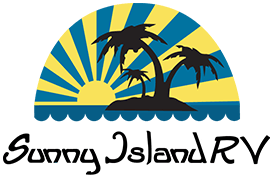Towing with a Motorhome
There are two main types of RV: towable models that are pulled behind a car or truck, and motorhomes that have their own drivetrain and don’t need another vehicle to haul them around. Some people use their motorhomes as a kind of inverse towable camper, lugging a car or truck behind their motorized RV.
Benefits of Towing Your Car
Even though you don’t need your car for an RV trip in a motorhome, many find it convenient to have another vehicle on hand. Most motorhomes are big enough to need multiple parking spaces. They can be heavier and more difficult to drive than the average car. Even the smallest Class Bs are a little unwieldy when it comes to narrow or winding roads. If you just want to make a quick grocery run, it is far easier to just hop into your car instead of using your RV.
Before You Tow
Motorhomes follow the same rules when it comes to towing as any other vehicle. You need to know the towing weight limit and be careful never to exceed that limit. There are actually a few numbers to know when it comes to towing in a motorhome, so we’ll take you through what each means and how to find them below.
The curb weight is the full weight of your vehicle and can be found in the door jam sticker. The gross vehicle weight rating is a bit tricky because it shows your vehicle’s maximum weight capacity and includes the weight of cargo and passengers but not anything towed behind the vehicles. For that reason, you’ll want the gross combined weight rating, which is the maximum weight of the RV, any passengers, the cargo, and the trailer as well. Equally as important is the max gross trailer weight. This number represents the total amount of weight the hitch can handle, and can be found on a sticker on the hitch itself.
Each of these numbers is important. You can’t tow safely if you exceed the hitch’s limit, so the first thing you should do is ensure that your car doesn’t exceed the max gross trailer weight limit. Next, use the gross vehicle weight rating to make sure that your motorhome isn’t overburdened with people and supplies. Finally, add the weight of your RV to the weight of the vehicle you will be towing to make sure it is within the gross combined weight rating. Trying to exceed these weight limits can lead to damage or accidents.
Tow Dollies
A tow dolly is a small two-wheel trailer. With this method, two of your car’s wheels will be on the road and two will be off the ground while you tow. Tow dollies can be used by any car, and the load will remain stable. However, this method can also make turning and braking more difficult and some states require a license in order to use it.
Tow Bars
Tow bars come with a few disadvantages. Firstly, they can only be used with cars that have manual transmissions and four-wheel drive. They also require that you modify your motorhome by adding a towing plate, which usually requires a professional to install it properly. Once installed, tow bars are very quick and easy to use.
Enclosed and Flatbed Trailers
Enclosed and flatbed trailers are the most versatile option. Not only do they work on any car regardless of transmission, but they require no alterations to your camper. Even better, these trailers can be used to transport other kinds of cargo if you decide you won’t need your car on a particular trip. However, enclosed and flatbed trailers are also the heaviest and most expensive option of the three, so think carefully about what you can afford and how much your RV can tow.
For all your RV and trailer needs, visit Sunny Island RV. We offer parts, financing, and servicing, with friendly staff on hand to answer your questions. Be sure to visit us at our dealership in Rockford, Illinois. We are conveniently located within two hours of cities like Naperville and Chicago, so stop by whenever you wish to look at our selection of new and pre-owned RVs.
